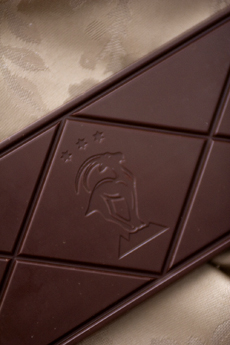

The Scharffen Berger logo features an ibex mountain goat and three stars. All photography by Saidi Granados.
|
PETER ROT is the THE NIBBLE’s chocolate specialist.
|
September 2008
|
 |
Scharffen Berger Chocolate
American Chocolate Bars Help The Growth Of Artisan Chocolate
Page 1: Introduction
CAPSULE REPORT: In 1996,winemaker John Scharffenberger and physician Robert Steinberg made a mark in the history of chocolate, shaping the current trend of “micro” (small-batch) chocolate bar production in the U.S. and, as a result, decentralizing the production of fine chocolate bars in Europe. Their fine artisan chocolate grew so popular with consumers and pastry chefs that, in less than 10 years, they helped build a great demand for artisan chocolate in America and were purchased by the country’s largest chocolate maker, Hershey. The line is certified kosher by OU. This is Page 1 of a six-page article. Click on the black links below to visit other pages.
Introduction To Gourmet Chocolate Bars
Buying a gourmet chocolate bar used to be as simple as choosing from a slender selection of milk, dark or the occasional white chocolate bars*, some embellished with nuts or dried fruits. Dark chocolate might be labeled “semisweet” or “bittersweet,” without any other indication.
*See Peter Rot’s review of the world’s best white chocolate bars.
A lot has changed in the last ten years, as more people have become focused on learning about chocolate (and all categories of fine food). Today, there is an amazing diversity of chocolate for the asking, thanks to consumer interest and to passionate chocolate makers who produce couverture and bars from raw cacao beans. (See Peter Rot’s choices of the best microbatch chocolate makers in America—individuals or tiny companies that produce great bars.)
Cacao Content
Bars differing in cacao contents (% cacao) have swept the retail market by storm, especially after news broke that chocolate contains antioxidants.† Almost out of nowhere, bars of 70% cacao were viewed as “health food,” their hefty cacao content boasting the highest concentration of antioxidants that most consumer palates could tolerate. The typical newsstand milk chocolate bar has 30% to 33% cacao, the dark chocolate bar 50% to 55% cacao. The higher the cacao percentage, the lower the sugar content and the more bitter the chocolate. The more bitter the chocolate, the less palatable it is to most people, especially Americans, many of whom have grown up on very sweet milk chocolate.
†As nice as it is to think that chocolate is healthy, it really isn’t. The main component of chocolate is cocoa butter, which is pure fat (although, like olive oil, a heart-healthy fat). A bar at 70% cacao content contains 40% cocoa butter and 30% sugar, which leaves 30% for cacao particles, which is what delivers the antioxidants. So by the time you eat enough chocolate to actually receive benefits from its antioxidants, you will have consumed more calories and fat than is recommended for a well balanced diet. Cocoa powder, however, is low in fat and calories and consists of 100% cacao particles, thus making it a better source of antioxidants than chocolate.
More daring palates began eating bars at 85% cacao and higher, and once the concept of origin chocolate leaked into the public, the world of chocolate has never been more populated.
Continue To Page 2: Origin Chocolate
Go To The Article Index Above
WHAT’S THE DIFFERENCE BETWEEN COCOA AND CACAO?
Among professionals, cocoa is the English-language term for the ground powder made from cacao and the beverage made from the powder.
Cacao is the tree, its pods, the beans (seeds) in the pods and the interim products derived from the beans, which are made into chocolate. |
Lifestyle Direct, Inc. All rights reserved. Images are the copyright of their respective owners.

|




